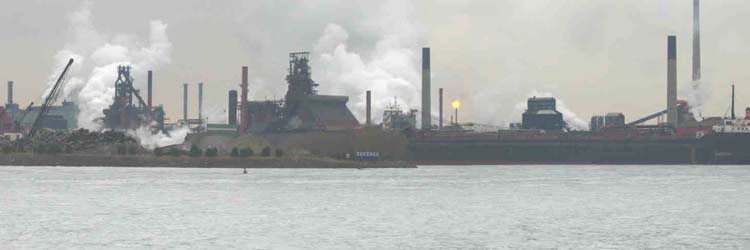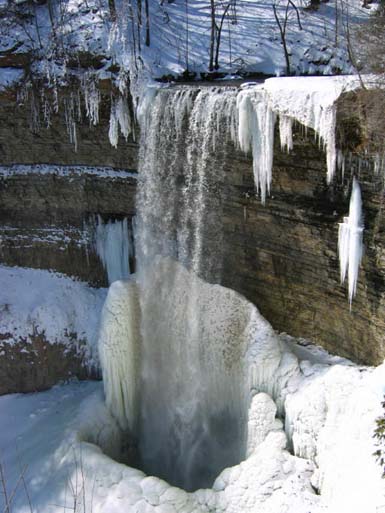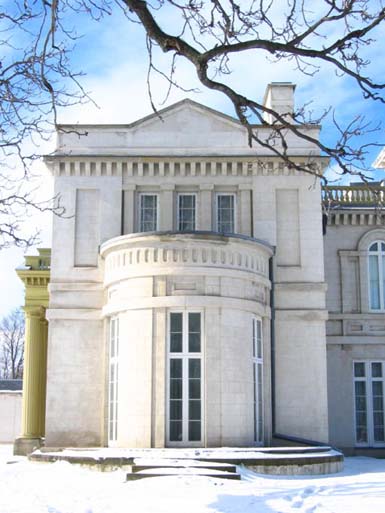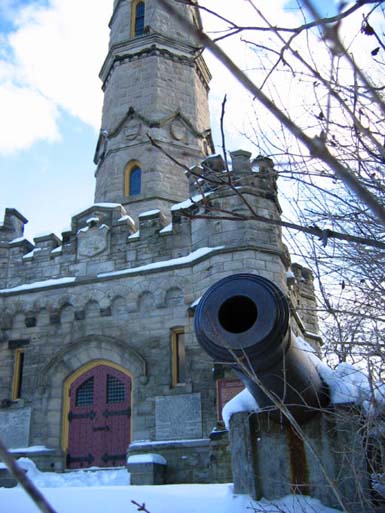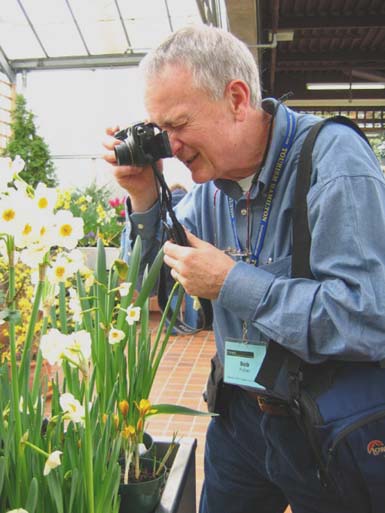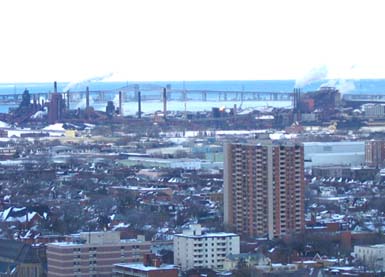I started in the industrial sector, where
the machinery of society’s underworld towered over me with
flames shooting high from tall stacks, giant claws hoisting mounds
of metal, and smoke trudging across a skyline punctuated by towers,
derricks and vast dirty buildings. There was no mistaking the industrial
might of Hamilton.
My first stop, the
Museum of Steam and Technology, typified everything
I was to see: below the gritty industrial veneer lies unexpected
beauty and enchanting history. The museum houses the original waterworks
dating from 1859. Two thundering 70-ton coal-fired steam engines
and pistons — still operable today — pumped clean water
throughout the city. The greatest benefit at the time was the eradication
of cholera, which wrought a deadly death toll in those days. A great
engineering achievement, the waterworks was a major contributor
to making Hamilton prosper, a much-needed industrial asset to an
evolving economy.
What astonished me, however, is that the
plant is a gleaming work of art! The tall pistons are designed like
Greek columns, the machinery is painted in pleasing colours and
much of the machinery is made of rich walnut and polished brass.
Driving westward, I saw a dramatic transformation.
The harbourfront changed from industrial to people-friendly, lined
with parks, marinas and a waterfront trail that extends for miles.
Two new facilities, in particular, symbolize the bold revitalization
of the harbour over the past decade. The
Canada Marine Discovery Centre is a striking building
perched on the water’s edge drawing its themes from marine
ecology, conservation and ship-building. I wandered through interactive
exhibits that made the subsea world come alive.
Then, a short stroll took me to Pier
9 and the Haida, a destroyer known as the
“fightingest ship in the Royal Canadian Navy” for having
sunk 14 enemy boats during the Second World War. Now a Canadian
National Historic Site, it offers an insight into Canada’s
naval heritage, especially important in the Second World War. Dodging
under long gun barrels and with multi-coloured flags snapping in
the wind, I imagined the Haida ploughing through a stormy
sea with guns blazing.
Next my odyssey took me to the tall office
blocks of downtown. The
Art Gallery of Hamilton, the third largest in Ontario
and one of the oldest in Canada, anchors the city’s vibrant
cultural scene. It has undergone a multi-million-dollar facelift
and is a symbol and proof of the fruits of the labour of untold
numbers of working class people who helped build the economic engine
that Hamilton represents.
The adjacent Hamilton
Place hosts big-name shows and is home to the city’s
opera and philharmonic orchestra. Locke Street South — LoSo
to locals — has become a funky place to shop with antique
shops, cafés, and boutiques. And for nightlife, I was advised
that Hess Village,
which features lively bars, music, and restaurants, is the place
“to hang.”
A highlight of my tour was the Royal
Botanical Gardens, a rambling garden of Eden occupying
2,700 acres, the largest in Canada. Its formal gardens contain over
40,000 recorded plants, including the world’s largest collection
of lilacs. As we strolled along part of the 30 kilometres of trails
through nature sanctuaries and marshlands, Carl Rothfels, the Garden’s
land steward, explained, “I’ve travelled around the
world, and Hamilton has the most amazing natural areas.” He
enthusiastically described the Carolinian
forest, the marshes and the escarpment
that form part of the Gardens.
Next I was drawn to a prominent mansion,
Dundurn Castle, that is a Hamilton icon and
a National Historic Site. The “upstairs maid” guided
me through more than 40 rooms, about half with fireplaces, and explained
life in the mid 1800s, or at least how it was lived by the wealthy
Sir Allan MacNab, a real-estate entrepreneur
and prime minister of the Provinces of Upper and Lower Canada (which
preceded the “Dominion of Canada” as we know it today.
Saving the best for last, I turned the car
toward the “Mountain”, or the
Niagara Escarpment, a long ridge whose sweeping bend
embraces Hamilton. The escarpment was selected as a UN Biosphere
Reserve because of its unique geology and natural life, which is
protected by a string of parks and conservation areas. Thus, Hamilton
contains some of the most delightful nature and topography in eastern
Canada, highlighted by more than 26 breathtaking waterfalls.
My escarpment exploration started at the
Battlefield Museum and Park, yet another National
Historic Site. Costumed interpreters explained how the pivotal battle
of the
War of 1812 was fought on this rise, with 700 Britishers
defeating a 3000-strong American force in a surprise night attack.
As I wandered through the Gage family home and the expansive grounds,
I envisioned the bloody battle and how all of Niagara would be belong
to the United States today, if the outcome had been different.
I continued along the
Bruce Trail through the Carolinian forest passing moss-covered
boulders and delicate ferns. Soon I was at the Devil’s Punch
Bowl a deep curve sculpted out of the cliff with a thin cascade
of water falling delicately downward glistening in the sunshine.
I was alone in paradise. Later, I hiked to Webster’s Falls
and marvelled as Spencer’s Creek bubbled under the arch of
an old stone bridge before tumbling over the steep cliff.
Driving homeward, I regretted not having
discovered Hamilton sooner, for like Beauty and the Beast, its dual
personality is often misunderstood or taken for granted. Like many
industrial-base cities, there is much more to Hamilton than initially
meets the eye. Its idiosyncratic charm is the product of the city’s
vast natural and historical bounty and its crucial industrial heritage.
Hamilton, Ontario is a sister
city to Sarasota, Florida.
